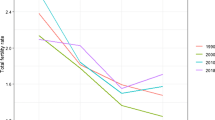Abstract
The basic ideas underlying the analysis in this paper are that family size can be viewed as an economic life cycle decision and that there are decision trade-offs among fertility, consumption, and leisure. A micromodel of life cycle choice is developed and embedded in an economic-demographic macromodel. The macromodel is then used in a series of computer experiments to assess the effects on the population and the economy of changes in household preferences for children. The experiments include “factual” and “counterfactual” simulations of Canadian historical demographic experience and simulations of alternative future scenarios. The analysis and conclusions have general relevance for countries that have been through a fertility boom-and-bust sequence.
Similar content being viewed by others
References
Ahlburg DA (1982) The new Kuznets cycle: A test of the Easterlin-Wachter hypothesis. Res Popul Econ 4:93–115
Barro RJ, Becker GS (1988) Fertility choice in a model of economic growth. Economics Research Centre, NORC/University of Chicago Discussion Paper 88-8
Becker GS, Barro RJ (1988) A reformulation of the economic theory of fertility. Q J Econ 103 (1):1–25
Ben-Porath Y (1975) First generation effects on second generation fertility. Demography 12 (3):397–405
Butz WP, Ward MP (1979) The emergence of countercyclical U.S. fertility. Am Econ Rev 69 (3):318 -328
Cigno A (1988) Some macroeconomic consequences of the ”New home economics“. In: Lee RD, Arthur W, Rodgers G (eds) Economics of changing age distributions in developed countries. Oxford University Press, Oxford, pp 139–150
Denton FT, Spencer BG (1975) Population and the economy. DC Heath, Lexington
Denton FT, Spencer BG (1983) Macroeconomic aspects of the transition to zero population growth. In: Garbacz Ch (ed) Economic resources for the elderly. Westview Press, Boulder, pp 81–111
Denton FT, Spencer BG (1984) The time path of the economy as the population moves towards a stationary state. In: Steinmann G (ed) Economic consequences of population change in industrialized countries. Springer, Berlin Heidelberg New York, pp 109–131
Denton FT, Spencer BG (1988a) Endogenous versus exogenous fertility: What difference for the macroeconomy? In: Lee RD, Arthur WB, Rodgers G (eds) Economics of changing age distributions in developed countries. Oxford University Press, Oxford pp 183–215
Denton FT, Spencer BG (1988b) Fertility, population, and the economy: The macro-implications of alternative life cycle choices. McMaster University Program for Quantitative Studies in Economics and Population, Research Report No. 241 Easterlin RA (1962) The american baby boom in historical perspective. National Bureau of Economic Research, Occasional Paper 79
Easterlin RA (1966a) Economic-demographic interactions of long swings in economic growth. Am Econ Rev 56 (5):1063–1104
Easterlin RA (1966b) On the relation of economic factors to recent and projected-fertility changes. Demography 3:131–153
Easterlin RA (1968) Population, labor force and long swings in economic growth: The American experience. Columbia University Press, New York
Easterlin RA (1969) Towards a socioeconomic theory of fertelity: A survey of recent research on economic factors in American fertility. In: Behrman SJ et al (eds) Fertility and family planning: A world view. University of Michigan Press, Ann Arbor, pp 127–156
Easterlin RA (1973) Relative economic status and the American fertility swing. In: Sheldon EB (ed) Family economic behavior: Problems and prospects. JB Lippincott, Philadelphia, pp 170–223
Easterlin RA (1978) What will 1984 be like? Socioeconomic implications of recent twists in age structure. Demography 15 (4):397–432
Easterlin RA, Wachter ML, Wachter SM (1978a) Demographic influences on economic stability: The US experience. Popul Dev Rev 4 (1):1–22
Easterlin RA, Wachter ML, Wacher SM (1978b) The changing impact of population swings on the American economy. Proceedings of the American Philosophic Society, vol 122, pp 119–130
Lee RD (1976) Demographic forecasting and the Easterlin hypothesis. Popul Dev Rev 2 (3/4):459–468
Lee RD (1981) A stock adjustment model of US marital fertility. Res Popul Econ 3:67–91
Lee RD (1987) Comment (on Schultz 1987). In: Davis K et al. (eds) Below-replacement fertility in industrial societies — Causes, consequences, policies. Cambridge University Press, New York, pp 108–110
Lee RD, Lapkoff Sh (1988) Intergenerational flows of time and goods: Consequences of slowing population growth. J Polit Econ 96 (3):618–651
McNicholl G (1987) Economic growth with below-replacement fertility. In: Davis K et al. (eds) Below-replacement fertility in industrial societies — Causes, consequences, policies. Cambridge University Press, New York, pp 217–238
Moffit RA (1982) Postwar fertility cycles and the Easterlin hypothesis: A life cycle approach. Res Popul Econ 4:237–252
Preston SH (1987) Changing values and falling birth rates. In: Davis K et al. (eds) Below-replacement fertility in industrial societies — Causes, consequences, policies. Cambridge University Press, New York, pp 176–195
Samuelson PA (1976) An economist's non-linear model of self-generated fertility waves. Popul Studies 30 (2):243–247
Schultz TP (1987) The value and allocation of time in high-income countries: Implications for fertility. In: Davis K et al. (eds) Below-replacement fertility in industrial societies — Causes, consequences, policies. Cambridge University Press, New York, pp 87–108
Wachter ML (1975) A time-series fertility equation: the potential for a baby-boom in the 1980s. Int Econ Rev 16 (3):609–624
Ward MP, Butz WP (1980) Completed fertility and its timing. J Polit Econ 88 (5):917–940
Author information
Authors and Affiliations
Additional information
We are grateful for the support received from Health and Welfare Canada's Review of Demography and Its Implications for Social and Economic Policy and from the Social Sciences and Humanities Research Council of Canada. We are grateful also to Christine H. Feaver, who carried out the computer-related aspects of the work on which this paper is based.
Rights and permissions
About this article
Cite this article
Denton, F.T., Spencer, B.G. Macro-effects of changes in household preferences for children. J Popul Econ 2, 165–188 (1989). https://doi.org/10.1007/BF00177322
Received:
Accepted:
Issue Date:
DOI: https://doi.org/10.1007/BF00177322




